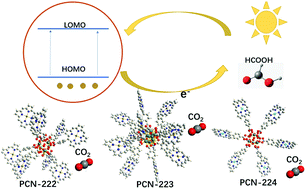Porphyrin-based metal–organic framework catalysts for photoreduction of CO2: understanding the effect of node connectivity and linker metalation on activity†
Abstract
Three zirconium–porphyrin based MOFs with different linker connectivity, PCN-222, PCN-223 and PCN-224, and their Zn(II) ion metalated analogues, were prepared and used as catalysts for the photoreduction of CO2 under visible-light irradiation. Before metalation with Zn2+ in the porphyrin linkers, the lowest linker-connected PCN-224 (6-fold) exhibited a higher formate yield rate of 45.2 μmol g−1 h−1 compared to PCN-222 and PCN-223. However, after the incorporation of Zn2+ into the porphyrin, PCN-222-Zn showed the highest formate yield rate of 120.2 μmol g−1 h−1. The density functional theory (DFT) computational results revealed that the catalytic activity correlated with the CO2 adsorption affinity. The CO2 adsorption energy on PCN-222-Zn (294.4 kJ mol−1) was the highest among all of the samples. The overall catalytic performance was affected by the Zr6-oxo cluster connectivity and the introduced dual reaction sites when the porphyrin linkers were metalated with Zn(II) ions.



 Please wait while we load your content...
Please wait while we load your content...